| Pages:
1
2 |
elbeau
Nomad
 
Posts: 256
Registered: 3-2-2011
Location: Austin, TX
Member Is Offline
|
|
Lost & Found: It may not be a lost mission, but this time it's for real :)
Hi Nomads,
As some of you may remember from my Santa Isabel thread from last year, I like doing reading about Baja archaeology. Although I don't tend to zoom in
quite as much when I use Google Earth these days, and although I don't have any wild treasure-hunting trips to send nomads on at the moment, I do
have a fun story to tell.
Anybody who has read much about Archaeology in Baja has probably come across the name "William Massey". In fact, from what I understand, his wife and
son are active Baja Nomads themselves. Anyways, William Massey worked doing archaeology in Baja California starting in the 1940's. He is known for
his scientific approach and his work is still quoted in many modern publications. Among his work is an article published in the Southwest Journal of
Anthropology in 1947 in which he states:
"For several miles to the west of the locality where the Arroyo de Comondu leaves its canyon, there is a plain of silts dissected by washes. From the
faunal remains-bison, camel, and horse-which have been collected in this fossil location,it is known that in Pleistocene times it was a marsh. No
artifacts have been found in place with these Pleistocene faunal remains,but the presence of longitudinally split bison bones, and reported camel and
horse bones with burned ends suggest the work of contemporaneous humans."
To translate this for us non-scientists, he said: "We found really old animal bones with tool marks that makes us think that people ate them". Since
these species appear to have all gone extinct about 10,000 years ago, these fossils could go a long ways towards documenting how long people have
lived in Baja.
Unfortunately, just a few years after he wrote that article he wrote in another publication that although those fossils did exist, he could no longer
produce them for further analysis. There are quite a few modern publications that reference this claim and which wish that the evidence of it could
be found and have further testing done, but nobody had been able to track down where the fossils went.
One day on a whim I decided to take up the subject of where the fossils may have gone, so on a lunch break from my normal job I stopped by the
University of Texas to see if I couldn't find something in their wonderful latin american libraries that might help. I didn't find anything new, but
as I browsed the 1947 article which I had read before, I noticed the footnote that said "Our remains were identified through the kindness of Dr R. A.
Stirton."
A minor amount of googling made it clear that he was referencing Reuben Arthur Stirton, the fourth director of the University of California's Museum
of Paleontology. I soon found myself browsing through the online lists of the museum's collections and found several collections by Massey, but none
that could be the fossils which he had mentioned. Before long I inadvertently bumped into a search result for a collection deposited by Annie
Alexander in 1948 which includes "DIST TIBIA,SCAPULA FRAG,HUMERUS,METACARPAL" from a Quarternary Bison and which was collected from "Comondu Arroyo 1"
in Baja California Sur.
I also soon found that the museum has a special section about Annie Alexander's collections which mentions correspondence between her and Massey.
Needless to say I thought I was onto something, and in very short order I contacted the museum and received the following response (edited for
length):
"You are a top-notch historical sleuth!"
that was my favorite part 
They went on to say "the bones...were right there in the drawer! I've taken a few quick pictures...They are now attached to the specimen record in
our online database here
<http://ucmpdb.berkeley.edu/cgi/ucmp_query2?&spec_id=V38331&one=T> and also accessible here
<http://calphotos.berkeley.edu/cgi/img_query?query_src=&where-specimen_no=V38331>"
He also noted "They are definitely blackened here and there" but that tests would need to be performed to see if the blackening was from the
fossilization process.
One thing that was lost in the mix was a separate email I sent them regarding other collections that Annie Alexander deposited from the same location
at the same time. The other collections are horse and camel bones which makes it likely that they are the blackened bones that Massey mentioned. If
you read the 1947 article it becomes apparent that there has been a misunderstanding about which fossils are expected to show the blackening. It's
not the bison bones, it's the horse and camel bones. The bison bones are expected to be longitudinally split, which the online photographs show
clearly. I am very curious to see what the horse and camel bones look like.
Again, I'm hardly a professional when it comes to this subject, but the bison scapula that the museum photographed for me looks intriguing to me. I
have read that these scapula were often used to make hoes in prehistoric times. As you look at the photo of the scapula, you will note that it has a
couple of holes in it. The larger hole looks particularly unusual to me and, in my completely unprofessional opinion, could have been made by a
projectile point or lithic tool, but this is pure speculation on my part of course.
My best guess as to why the fossils were lost in the first place is that Annie Alexander died just a couple of years after depositing the fossils and
Massey must not have known what became of them.
There are a couple of professional folks who are going to try to find some time to do some testing on the fossils, but they do not know when the work
might get started yet.
Let's all take our hats off to the University of California at Berkeley, and to Dr. Pat Holroyd who has been instrumental in preserving the fossils
for so long and specifically for her work and success in obtaining the funds and doing the labor necessary to document them and post them online.
From what I understand, before she started at the museum, the fossils were not documented and were simply stored in boxes underneath the football
stadium seats.
Dr. Holroyd, Thank you!
[Edited on 7-12-2012 by elbeau]
|
|
|
Taco de Baja
Super Nomad
   
Posts: 1913
Registered: 4-14-2004
Location: Behind the Orange Curtain, CA
Member Is Offline
Mood: Dreamin' of Baja
|
|
Very cool!
In looking at the photos (had to go to the UCMP site, as your links did not work) the "burned" areas look like mineral stains to me. The other issue
is, is if they were associated with humans, there would likely have been some artifacts, at a minimum some flakes, points, scrapers, grinding stones,
charcoal, something. As a professional archaeologist, the person who found the fossil bones would have known what to look for. Of course, the
"burned" bones he refers too may be other bones that are not in the UCMP collections.....But I have a strong feeling, that they too would turn out to
be mineral deposits. Also, if there were people here longitudinally splitting bones, there would be stone tools all over the place that were used to
split the bone. The split bones are likely natural.
My guess is, it is "simply" a fossil locality. Not that there is anything wrong with that. 
I have dealt with Dr. Holroyd numerous times and also found her to be very helpful in paleontological research.
Truth generally lies in the coordination of antagonistic opinions
-Herbert Spencer
|
|
|
David K
Honored Nomad
        
Posts: 65399
Registered: 8-30-2002
Location: San Diego County
Member Is Offline
Mood: Have Baja Fever
|
|
Hi Beau,
Of interest, my wife and I are leaving for La Paz this weekend and will be spending some time with the late Bill Massey's (step) son exploring sites
in Baja California Sur.
Lot's of photos coming in 2-3 weeks!
|
|
|
elbeau
Nomad
 
Posts: 256
Registered: 3-2-2011
Location: Austin, TX
Member Is Offline
|
|
| Quote: | Originally posted by Taco de Baja
Very cool!
In looking at the photos (had to go to the UCMP site, as your links did not work) the "burned" areas look like mineral stains to me. The other issue
is, is if they were associated with humans, there would likely have been some artifacts, at a minimum some flakes, points, scrapers, grinding stones,
charcoal, something. As a professional archaeologist, the person who found the fossil bones would have known what to look for. Of course, the
"burned" bones he refers too may be other bones that are not in the UCMP collections.....But I have a strong feeling, that they too would turn out to
be mineral deposits. Also, if there were people here longitudinally splitting bones, there would be stone tools all over the place that were used to
split the bone. The split bones are likely natural.
My guess is, it is "simply" a fossil locality. Not that there is anything wrong with that. 
I have dealt with Dr. Holroyd numerous times and also found her to be very helpful in paleontological research. |
Like you and Dr. Holroyd said, it is likely that the blackening is part of the fossilization process, but I still would love to see some photos of the
horse and camel bones. The horse and camel bones are listed in the museum's collections, but as emails were forwarded from one person to another when
I looked into this, the one that mentioned the horse and camel bone collections did not make it to Dr. Holroyd before she went and took photographs so
we only have photos of the bison bones for now.
Whether or not the bones end up showing human interaction, in the very least the issue Massey proposed back in 1947 now has potential to be put to the
test.
|
|
|
elbeau
Nomad
 
Posts: 256
Registered: 3-2-2011
Location: Austin, TX
Member Is Offline
|
|
| Quote: | Originally posted by David K
Hi Beau,
Of interest, my wife and I are leaving for La Paz this weekend and will be spending some time with the late Bill Massey's (step) son exploring sites
in Baja California Sur.
Lot's of photos coming in 2-3 weeks! |
Now you're just trying to make me jealous! 
...it's working
|
|
|
David K
Honored Nomad
        
Posts: 65399
Registered: 8-30-2002
Location: San Diego County
Member Is Offline
Mood: Have Baja Fever
|
|
Isn't it fun... I get to tease you for a change with 'lost treasure' talk! 
|
|
|
elbeau
Nomad
 
Posts: 256
Registered: 3-2-2011
Location: Austin, TX
Member Is Offline
|
|
| Quote: | Originally posted by Taco de Baja
...As a professional archaeologist, the person who found the fossil bones would have known what to look for....Also, if there were people here
longitudinally splitting bones, there would be stone tools all over the place that were used to split the bone... |
As far as I can tell, we cannot yet be sure who exactly collected the bones. Massey, an archaeologist, reported on them, but Alexander, a
paleontologist (who celebrated her 80th birthday during that expedition), is listed as the person who deposited the collection in the museum archives.
In either case, Massey's quote still isn't quite clear enough to say that the fossils were necessarily found by their expedition, although it is
likely.
Most of what Massey reported on archaeologically was not from the area he describes for the fossils. The fossils sound like they came from the
alluvial fan which leaves the possibility that any tool usage might have happened upstream rather than at the collection site. ...agian, I'm just
wildly speculating here.
|
|
|
David K
Honored Nomad
        
Posts: 65399
Registered: 8-30-2002
Location: San Diego County
Member Is Offline
Mood: Have Baja Fever
|
|
More on Bill Massey
In this book:
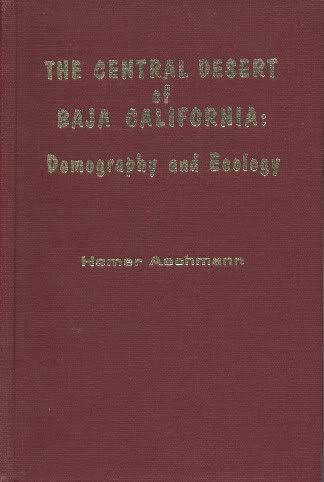
Below are the full pages, followed by a zoom in of the Massey parts for easier reading:
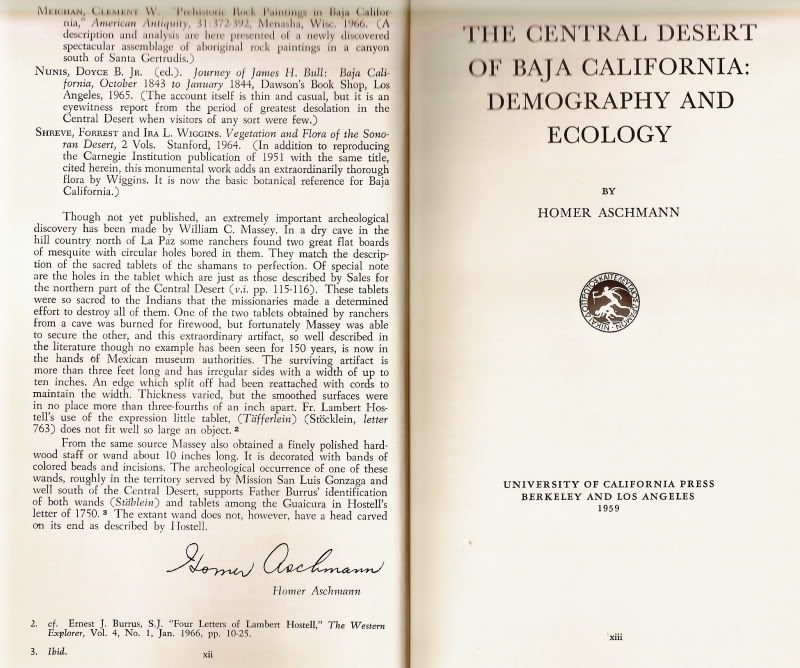
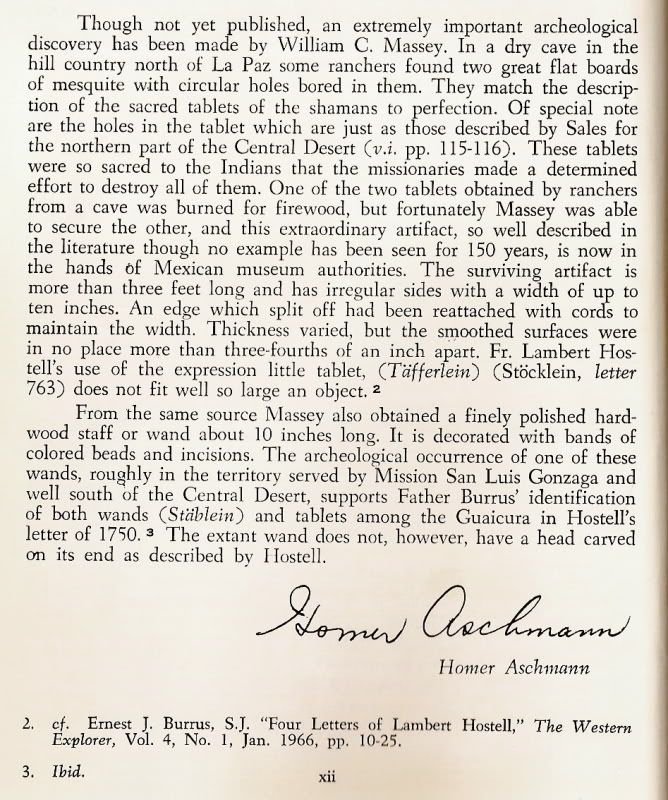
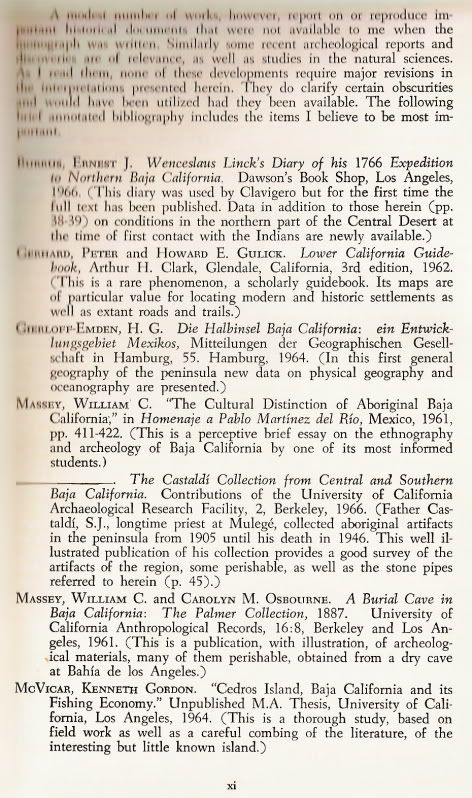
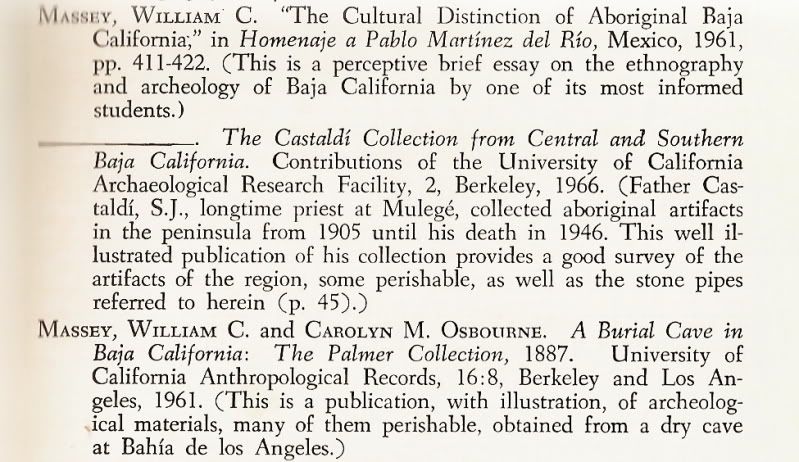
|
|
|
dtbushpilot
Ultra Nomad
    
Posts: 3296
Registered: 1-11-2007
Location: Buena Vista BCS
Member Is Offline
Mood: Tranquilo
|
|
Sounds like this has all the makings of a Baja adventure.....who wants to go fossil hunting?.....dt
"Life is tough".....It's even tougher if you're stupid.....
|
|
|
wilderone
Ultra Nomad
    
Posts: 3894
Registered: 2-9-2004
Member Is Offline
|
|
who wants to go fossil hunting?.....
Me.
elbeau - wonderful history study - thanks.
|
|
|
David K
Honored Nomad
        
Posts: 65399
Registered: 8-30-2002
Location: San Diego County
Member Is Offline
Mood: Have Baja Fever
|
|
Seen my pics of Day 12?
|
|
|
TMW
Select Nomad
      
Posts: 10659
Registered: 9-1-2003
Location: Bakersfield, CA
Member Is Offline
|
|
This is the first I've heard of camels being in Baja. I thought the US Army brought them over in the late 1800s for the deserts of the southwest.
|
|
|
David K
Honored Nomad
        
Posts: 65399
Registered: 8-30-2002
Location: San Diego County
Member Is Offline
Mood: Have Baja Fever
|
|
I think they are talking fossil camel bones, like from before the last ice age?
|
|
|
woody with a view
PITA Nomad
      
Posts: 15940
Registered: 11-8-2004
Location: Looking at the Coronado Islands
Member Is Offline
Mood: Everchangin'
|
|
maybe if this global warming thing gets off the ground the camels will return to Baja. kinda like the swallows and Capistrano......
|
|
|
BajaBlanca
Select Nomad
      
Posts: 13242
Registered: 10-28-2008
Location: La Bocana, BCS
Member Is Offline
|
|
what fun ...wish I could go back in time and study archeology. the local LA BOCANA fishing cooperative has a collection of bones that one guy found -
no one here can figure out what the HUGE animal the bones belonged to.
|
|
|
BajaNomad
Super Administrator
        
Posts: 5014
Registered: 8-1-2002
Location: San Diego, CA
Member Is Offline
Mood: INTP-A
|
|
| Quote: | Originally posted by elbeau
They are now attached to the specimen record in our online database here
<http://ucmpdb.berkeley.edu/cgi/ucmp_query2?&spec_id=V38331&one=T> and also accessible here
<http://calphotos.berkeley.edu/cgi/img_query?query_src=&where-specimen_no=V38331>"
|
The search times-out. Anyone wanting to recreate the search can go here:
http://ucmpdb.berkeley.edu
And search for items in Baja California Sur (over 600 listed - but only this 1 has photos associated with it) OR simply search for
"Spec no." 38331.
38331 has these 5 pics with it that Dr. Holroyd took in April:
http://calphotos.berkeley.edu/imgs/512x768/0000_0000/0412/17...
http://calphotos.berkeley.edu/imgs/512x768/0000_0000/0412/17...
http://calphotos.berkeley.edu/imgs/512x768/0000_0000/0412/17...
http://calphotos.berkeley.edu/imgs/512x768/0000_0000/0412/17...
http://calphotos.berkeley.edu/imgs/512x768/0000_0000/0412/17...
When I was young, I admired clever people. Now that I am old, I admire kind people.
– Rabbi Abraham Joshua Heschel
We know we must go back if we live, and we don`t know why.
– John Steinbeck, Log from the Sea of Cortez
https://www.regionalinternet.com
Affordable Domain Name Registration/Management & cPanel Web Hosting - since 1999 |
|
|
wilderone
Ultra Nomad
    
Posts: 3894
Registered: 2-9-2004
Member Is Offline
|
|
Blanca - do you know more about the bones? Where were they found? Does he still have them? Can they be identified as thigh, neck, foot, rib, etc?
|
|
|
elbeau
Nomad
 
Posts: 256
Registered: 3-2-2011
Location: Austin, TX
Member Is Offline
|
|
| Quote: | Originally posted by David K
I think they are talking fossil camel bones, like from before the last ice age? |
At the end of the Pleistocene/beginning of the Holocene (roughly 10,000 - 12,000) years ago, there was a massive extinction of what the call the North
American megafauna. This included American horses, camels, mammoths, HUGE bison (not the puny bison we have now), massive wolves, and many other
species.
The fossils found in the La Brea tar pits in L.A. are some of the best examples of what you would have found roaming Baja back then.
With how isolated Baja is, and as a result, how prone Baja is to endemic species, it would be interesting if someone could establish the timeline for
when these species went extinct in Baja. It's a remote enough place that it is possible that some animals might have survived the extinction longer on
the peninsula...much like recent findings that small versions of the mammoth survived on remote islands near Alaska and elsewhere until just 5,000
years ago.
|
|
|
David K
Honored Nomad
        
Posts: 65399
Registered: 8-30-2002
Location: San Diego County
Member Is Offline
Mood: Have Baja Fever
|
|
Yup, I am sure there are plenty of fossils still to find in Baja... look how easy it was for ys to walk around and find 'baby' prehistoric sharks
teeth. Las Pintas and Santa Catarina and El Rosario have rich fossil discoveries.
|
|
|
bajalera
Super Nomad
   
Posts: 1875
Registered: 10-15-2003
Location: Santa Maria CA
Member Is Offline
|
|
To update the info on the two flat boards [tablas] mentioned by Homer Aschmann, these were described in "Tabla and Atlatl:Two Unusual Artifacts from
Baja California" (Vol. 8 of the Pacific Coast Archaeologial Society Quarterly, 1972) by Lee Gooding Massey [me].
[Edited on 8-26-2012 by bajalera]
\"Very few things happen at the right time, and the rest never happen at all. The conscientious historian will correct these defects.\" -
Mark Twain
|
|
|
| Pages:
1
2 |

